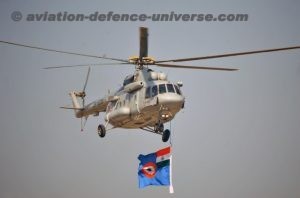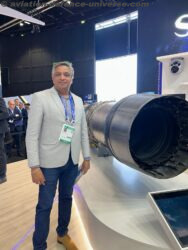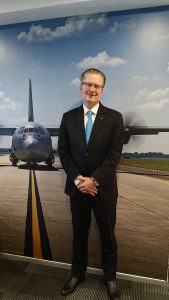
New Delhi. 07 October 2020. “Lockheed Martin also has an unmatched track record of establishing robust industrial capacity and capabilities in countries across the world via our 4th and 5th generation platforms. An F-21 selection would further a relationship with Lockheed Martin – the world’s pre-eminent designer, developer, manufacturer and sustainer of the world’s most advanced defense products and services and further integration into the world’s largest fighter ecosystem – a $165B sustainment market – will provide long-term and stable opportunities for Indian industry. Our partnership with the Indian aerospace and defence ecosystem coupled with our understanding of user requirements, offers us the unique advantage of being able to rapidly and efficiently realize our blue-print for the F-21 offer,” reiterated William L. Blair, Vice President and Chief Executive, Lockheed Martin India in an exclusive interview with Aviation & Defence Universe (ADU).
ADU. The C-130J has been a reliable workhorse for the Indian Air Force when it comes to carrying out high-altitude tactical and humanitarian airlift missions. What special configurations have been added to the Indian C-130Js to enable the same?
WB. The C-130 program represents a strong legacy of partnership between the U.S. and India. The Indian Air Force’s C-130J Super Hercules have a highly integrated and sophisticated configuration primarily designed to support India’s special operations requirement. Equipped with an Infrared Detection Set (IDS), the aircraft can perform precision low-level flying, airdrops and landing in blackout conditions.
Self-protection systems and other features are included to ensure aircraft survivability in hostile air defense environments. The aircraft are also equipped with air-to-air receiver refueling capability for extended range operations. India’s C-130Js have been used to support a variety of missions over the past few years, to include: humanitarian aid, natural disaster support (floods – an IAF C-130J was the first aircraft to land and extend support during the Nepal earthquake), airlift, search and rescue, and special operations.
Most recently, IAF has been extensively using the Indian Hercs for humanitarian efforts in the wake of the COVID-19 pandemic (for delivering critical medical equipment, medicines, PPEs, sanitizers and other essentials to remote places, airlifting teams of Indian military doctors to countries like Nepal, the Maldives and Kuwait), and for movement of man and material to the forward areas in light of India China border clash.
The C-130J is the only airlifter that can seamlessly handle all of India’s challenging terrain, from short, unprepared landing strips in the Himalayan mountains to vast coastlines. The C-130J’s rugged reliability makes it an asset unmatched by other aircraft.
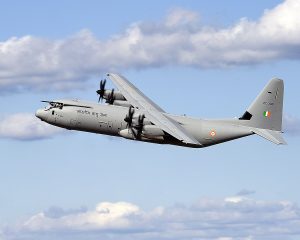
ADU. Lockheed Martin has been indigenously manufacturing major aerostructure components for the C-130J aircraft in India for almost a decade now. Can you please update us about the progress on the same?
WB. The C-130 is currently Lockheed Martin’s largest single programme/partnership in India. All C-130Js delivered to customers around the world have major aerostructure components from India included in their build through partnership with Tata in Hyderabad, India. Tata Lockheed Martin Aerostructures Limited (TLMAL) is a joint venture established in 2010 between Tata Advanced Systems Limited (TASL) and Lockheed Martin Aeroframe Corporation and it began producing C-130J Super Hercules airframe components in late 2011.
In April 2018, TLMAL increased the indigenization of C-130 manufacturing by transitioning the production of approximately 2,000 (of 2300) previously imported empennage parts to Tata Sikorsky Aerospace Limited (TSAL), our other joint venture in India. These parts were previously manufactured by suppliers located outside of India.
TLMAL not only exemplifies the Government of India’s “Make in India” objectives, but it has the distinction of being the single global source of C-130J empennage assemblies included on all new Super Hercules aircraft produced in Marietta, Georgia, in the United States of America.
To date, TLMAL has manufactured 130 C-130J empennages. This bears testimony to our contribution to the development of Indo-U.S. defense industrial partnership.
ADU. Tell us about the Simulation Training Facilities set-up for the IAF’s C-130Js Fleet, and about your C-130J Maintenance & Aircrew Training System (MATS)?
WB. In partnership with Mahindra Defence Systems, Lockheed Martin is meeting the increasing global demand for C-130J military flight training for the Indian Air Force at the C-130J Super Hercules simulator training center at Hindon Air Station in India. This state-of-the-art training center provides qualitative and quantitative training to C-130J pilots, combat system operators and loadmasters. Through realistic and holistic learning environments, crew members are able to hone critical tactical and operational skills to conduct a variety of missions including humanitarian aid, natural disaster support, airlift, search and rescue and special operations.
For all nations operating C-130Js, the Lockheed Martin C-130J Maintenance and Aircrew Training System (MATS) program provides a comprehensive range of training devices and training support services teaching aircrew and maintenance personnel without having to step foot in an aircraft. Launched in 2000, the program provides training devices, training aids, device modernization, and courseware development for C-130J pilots, loadmasters, maintainers, combat system operators and crewmasters.
The C-130J MATS Program has delivered 36 flight simulators, 64 other simulators and 26 courses with more than 3,300 lessons across eight configurations to date with 26 additional new device deliveries planned through early 2024. In addition, the C-130J MATS Training Systems Support Center (TSSC) provides configuration management, engineering tasks and cybersecurity for the Air Mobility Command, Air National Guard and Naval Aviation Systems Command end users. The TSSC provides operational support across a wide range of infrastructure elements, keeping the training system current, configured, relevant and modern.
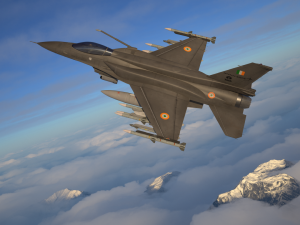
ADU. F-21 is Lockheed Martin’s offering for the 114-fighter jet competition for the Indian Air Force. What are the new technologies that have been added to the F-21 aircraft to differentiate it from the F-16 Block-70?
WB. We are confident that the F-21 is the best solution to meet or exceed the Indian Air Force’s capability needs, provide Make in India industrial opportunities, and accelerate India-U.S. cooperation on advanced technologies, including but not limited to fighter aircraft.
While aircraft structure for F-21 and F-16 may look familiar, the differences between them become clear when looking at the unique capabilities of the F-21, including: an advanced APG-83 Active Electronically Scanned Array (AESA) radar, which has detection ranges nearly double that of previous mechanically scanned array radars and the ability to track and attack more targets with higher precision; an Advanced Electronic Warfare (EW) System, developed uniquely for India, that provides enhanced survivability against ground and air threats; Long-Range Infrared Search & Track (IRST), enabling pilots to passively detect threats; Triple Missile Launcher Adapters (TMLAs) allowing the F-21 to carry 40 percent more air-to-air weapons than previous F-16 designs; and a Dorsal Fairing enabling increased growth capacity and indigenous systems integration in the future. The F-21 is also the only fighter in the world capable of both probe/drogue and boom aerial fueling capability. This, along with Conformal Fuel Tanks (CFTs), delivers greater range penetration and loiter staying power to the Indian Air Force.
The selection of the F-21 will place India at the epicentre of a USD 165 billion market for future opportunities with possibilities for expansion of footprints, further development of indigenous capabilities and global supplier relationships. The F-21 aircraft also complements IAF’s existing fleet as its fits right in between the Tejas and Rafale to provide an operational gap-filler. It will be a game-changer for the Indian Air Force, Indian industry, and India-US strategic ties.
The F-21 is also the only fighter in the world capable of both probe/drogue and boom aerial fueling capability. This, along with Conformal Fuel Tanks (CFTs), delivers greater range penetration and loiter staying power to the Indian Air Force. Simply put, the F-21 goes further, faster, and stays longer than the competition – all at the most optimal Life Cycle Cost for the Indian Air Force. Whether you’re talking about battlefields or budgets, the F-21 is the clear choice for India.
ADU. How will you leverage your existing partnerships in India for your F-21 offer?
WB. For more than three decades, we have been committed to technology development and strategic collaboration with India. Through our two JVs in Hyderabad with Tata, we have been supporting Make in India and Atma Nirbhar Bharat in defence manufacturing for over a decade now. The JVs and partners we have established over the last decade have generated value flowed down to Indian Tier 1/2/3 large, Micro, Small & Medium Enterprises (MSMEs) and start-ups supporting a foundation for the defense and aerospace ecosystem in India.
Our joint venture with Tata Advanced Systems Ltd., Tata Lockheed Martin Aerostructures Limited, in Hyderabad produces major aerostructure components for the C-130J Super Hercules transport aircraft. This is the sole supplier of these components to Lockheed Martin and is an integral part of our global supply chain.
Our other joint venture between Tata and Sikorsky Aircraft Corporation was established over 10 years ago. This JV manufactures aerospace components for commercial helicopters and aircraft and has expanded to include aircraft engine components for aerospace industry companies as well. It is also fully integrated into the global supply chain.
Both the JVs have been instrumental in helping India achieve its goal of developing an aerospace and defense supplier ecosystem, promote indigenous manufacturing and participating in the global supply chain. Nearly 240 suppliers feed into these two joint ventures and have benefited from the vision of Lockheed Martin and Tata working together.
ADU. Lockheed Martin signed an MoU with Bharat Electronics Limited to explore industrial opportunities in the F-21 program, could you please elaborate on what it entails?
WB. The F-21 will truly be a game-changer for the Indian Air Force, Indian industry, and India-US strategic ties. We are confident the F-21 is the best solution to meet the Indian Air Force’s capability needs, provide Make in India industrial opportunities, and accelerate India-US cooperation on advanced technologies, including but not limited to fighter aircraft.
At the 11th edition of DefExpo, we signed a Memorandum of Understanding (MoU) with Bharat Electronics Limited (BEL), a premier aerospace and defense company in India to explore industrial opportunities for the F-21 program. We are very excited about our MoU with BEL. BEL is a pre-eminent entity in the Indian aerospace ecosystem and has a proven ability and expertise in delivering sophisticated sensor systems. Furthermore, they have a knowledge and desire to work across the Indian defense ecosystem, while also have a long history of working with foreign suppliers.
Since DefExpo, our team has been actively engaged with BEL. To-date, we have sent them over a dozen RFIs to further understand their technical solutions as it relates to predominantly avionics systems in support of the F-21s advanced cockpit. We believe that an F-21 partnership with India integrates Indian industry, including BEL, into the world’s largest and most successful fighter aircraft ecosystem and demonstrates Lockheed Martin’s commitment to India. We continue to seek strategic relationships with the Indian Defence Public Sector and Private sector companies spanning large, MSMEs and start-ups to be both competitive and meet the Indian self-reliance initiatives and indigenous content requirements.


































